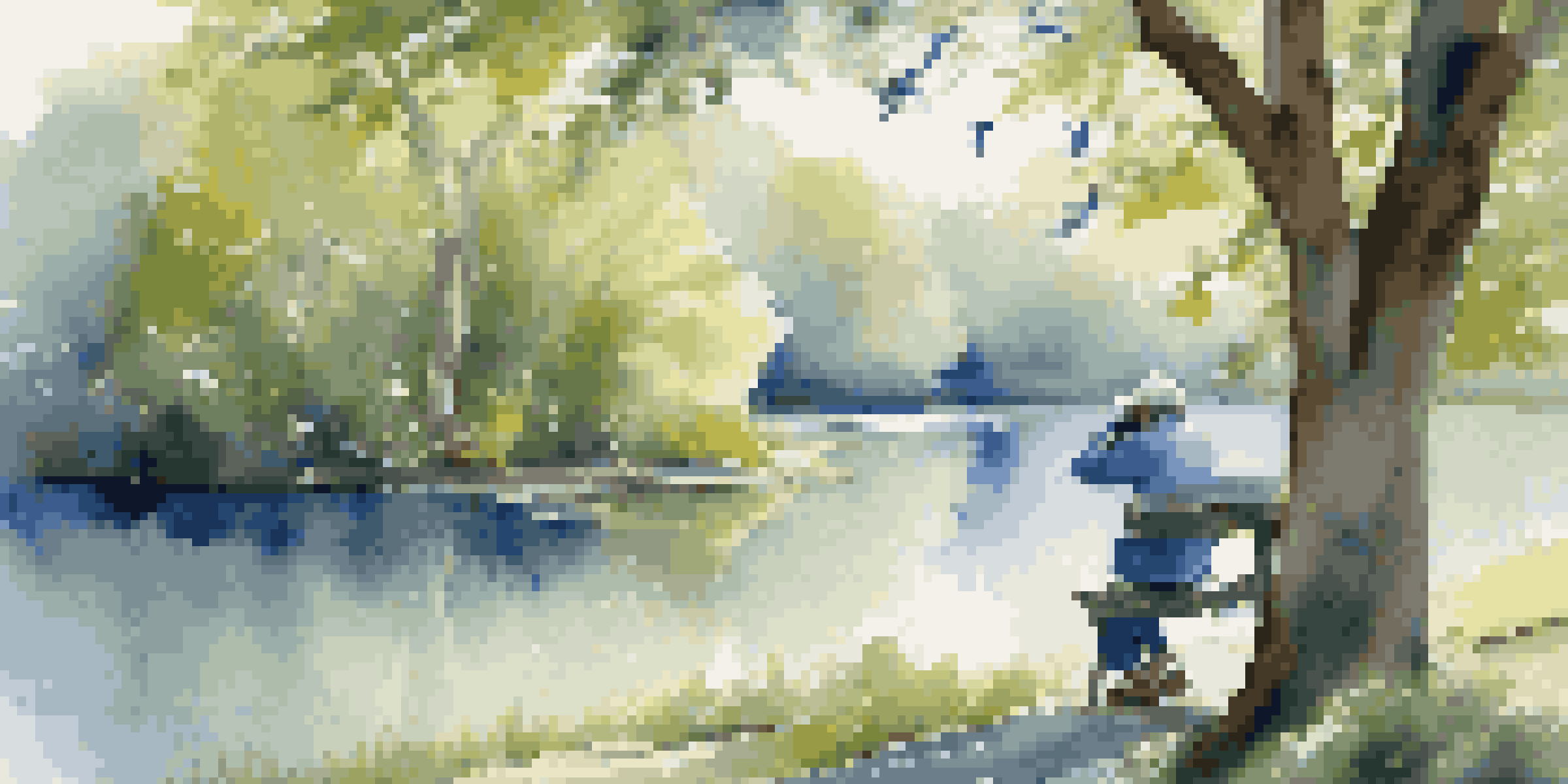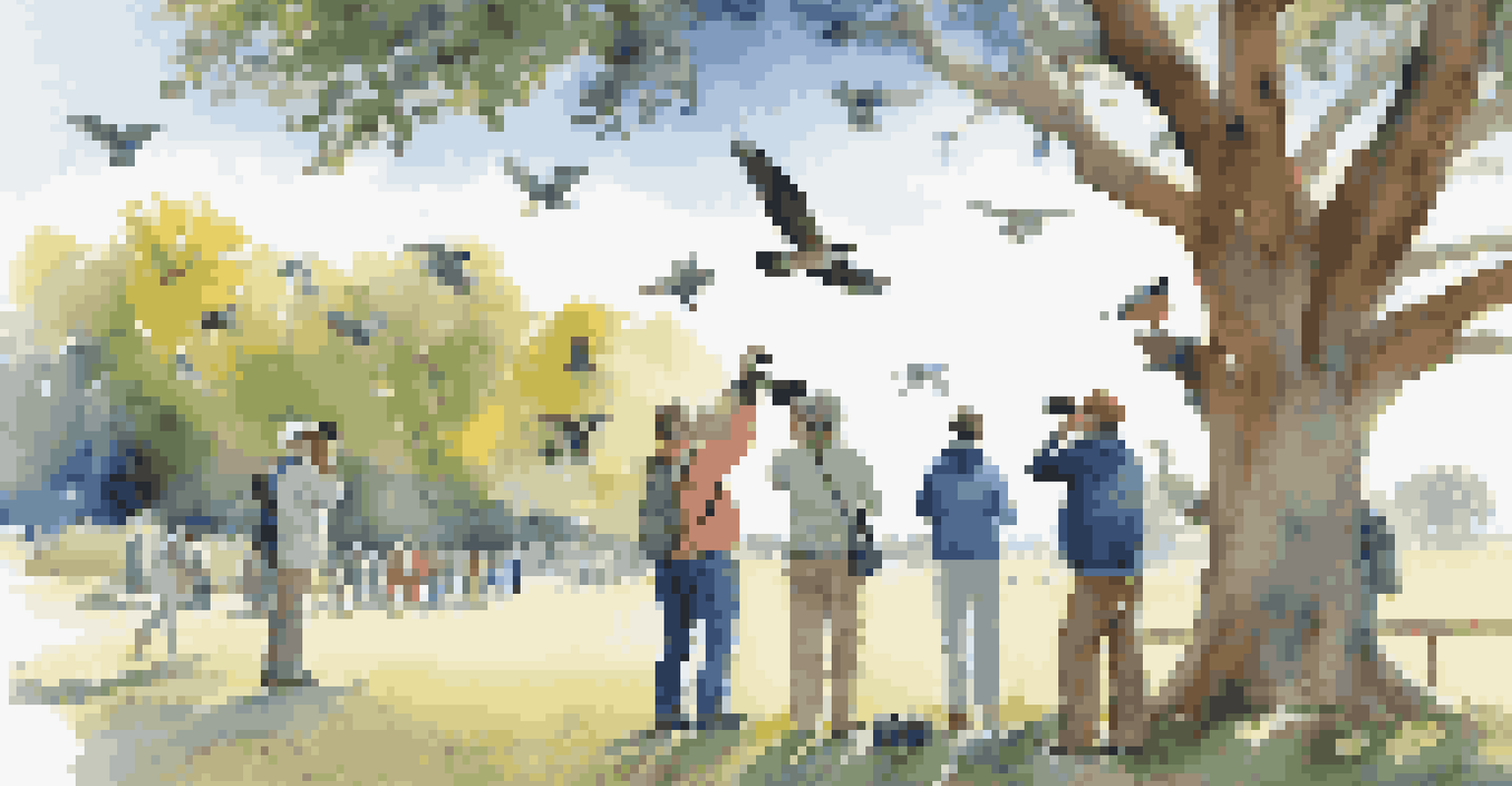Birdwatching in Your Local Park: What to Expect

Why Birdwatching is a Great Hobby for Everyone
Birdwatching is a delightful way to connect with nature, suitable for all ages. Whether you're a seasoned nature lover or a curious beginner, birdwatching can bring joy and tranquility to your life. Just imagine spending a peaceful morning in your local park, listening to the cheerful songs of birds flitting about.
In every walk with nature one receives far more than he seeks.
Not only does birdwatching allow you to enjoy the beauty of wildlife, but it also encourages mindfulness. By focusing on the birds around you, you can forget about your daily worries and immerse yourself in the moment. This simple shift in focus can be incredibly refreshing and rejuvenating.
Moreover, birdwatching can foster a sense of community. Joining local birdwatching groups or participating in community events can create lasting friendships with others who share your passion. It's a great way to meet new people and learn more about the avian world together.
Getting Started: Essential Gear for Birdwatching
Before heading out, it's important to have the right gear to enhance your birdwatching experience. At a minimum, a good pair of binoculars will help you see birds more clearly from a distance. Look for binoculars with a magnification of 8x to 10x and a comfortable grip for easy handling.

In addition to binoculars, consider bringing a field guide or a bird identification app. These resources can help you identify different bird species by their colors, shapes, and songs. Many apps even include features for tracking your sightings, making it easy to record your observations.
Birdwatching Enhances Mindfulness
Engaging in birdwatching allows individuals to immerse themselves in nature, promoting a refreshing sense of mindfulness.
Lastly, don't forget to dress appropriately for the weather and wear comfortable shoes for walking. A notebook or journal can also be handy for jotting down your thoughts or sketches of the birds you observe. The more prepared you are, the more enjoyable your birdwatching adventure will be.
Choosing the Best Time for Birdwatching
Timing plays a crucial role in birdwatching, as different species are more active during certain times of the day. Generally, early mornings and late afternoons are the best times to spot a variety of birds. During these hours, many birds are busy feeding and singing, making them easier to observe.
Birdwatching is a great way to connect with nature and enjoy the beauty of the world around us.
Seasonal changes also affect bird activity. Spring and fall are particularly exciting times for birdwatching, as migratory species pass through local parks. This seasonal influx can introduce you to new and rare birds that you might not see at other times of the year.
It's also helpful to pay attention to the weather. Overcast days can sometimes lead to increased bird activity, as many species prefer to forage during calm conditions. By being mindful of these factors, you can maximize your birdwatching experience and enjoy the thrill of spotting new species.
Finding and Attracting Birds in Your Park
To increase your chances of spotting birds, familiarize yourself with their habitats and preferred locations within the park. Birds often seek out areas with ample food sources, such as seeds, berries, and insects. Look for shrubs, trees, and open fields where birds may gather.
Creating a welcoming environment can also help attract birds. If your park allows it, consider setting up bird feeders with seeds or suet. Birdhouses can provide nesting sites, while native plants can offer natural food sources. These small efforts can enhance the birdwatching experience for everyone.
Essential Gear for Birdwatching
Having the right equipment, such as binoculars and a field guide, is crucial for a rewarding birdwatching experience.
Additionally, listen for bird calls and songs, as they can indicate a nearby presence. Different birds have distinct calls, so learning to recognize them can help you locate and identify what you see. Patience is key—sometimes, just sitting quietly in one spot can yield wonderful surprises.
Common Birds You Might See in Your Local Park
One of the joys of birdwatching is discovering the variety of species that inhabit your local park. Depending on your region, you might encounter familiar birds like sparrows, robins, and blue jays. Each species has unique behaviors and characteristics that make observing them fascinating.
In addition to the usual suspects, keep an eye out for migratory birds during the right seasons. You may spot species such as warblers, finches, or even the occasional hawk passing through. Each visit can bring new surprises, making every outing an adventure.
Don't forget to appreciate the smaller details, too. Pay attention to the differences in plumage, size, and behavior among birds. Observing these subtle nuances can deepen your understanding and appreciation of the avian world, turning each birdwatching session into a mini-education.
Capturing Your Birdwatching Adventures
Documenting your birdwatching experiences can be a rewarding way to reflect on your adventures. Consider keeping a birdwatching journal where you can note your sightings, thoughts, and feelings during each outing. This practice not only enhances your memory but also helps you track your progress over time.
Photography is another fantastic way to capture the beauty of birds. With a camera or even your smartphone, you can snap pictures of your feathered friends in action. Just remember to be respectful of their space and avoid disturbing their natural behaviors.
Community and Connection in Birding
Joining local birdwatching groups fosters community and provides opportunities to learn alongside fellow enthusiasts.
Sharing your experiences with friends and family can inspire them to join you in this wonderful hobby. Whether through social media, blogs, or casual conversations, sharing your stories can foster a greater appreciation for nature and encourage others to explore birdwatching themselves.
Joining the Birdwatching Community
As you dive deeper into birdwatching, consider connecting with local birdwatching groups or clubs. Many parks have organized events, workshops, or guided walks led by experienced birders. Joining these groups can enhance your skills and knowledge while providing opportunities to meet like-minded individuals.
Participating in community events can also help you stay informed about local bird populations and conservation efforts. Many organizations focus on protecting bird habitats and educating the public about the importance of biodiversity. By getting involved, you can contribute to these efforts while enjoying your hobby.

Finally, don’t hesitate to share your newfound passion with others. Encourage friends and family to join you in the park, or introduce them to the joys of birdwatching. The more people who appreciate and understand the beauty of birds, the better chance we have of preserving their habitats for future generations.